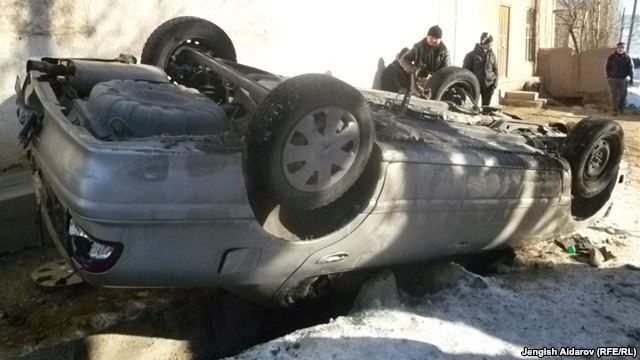
Fresh Border Incident Could Provoke New Inter-Ethnic Clashes in the Ferghana Valley
Publication: Eurasia Daily Monitor Volume: 10 Issue: 3
By:

Residents of Uzbekistan’s enclave of Sokh located within Batken province (southern Kyrgyzstan) attacked Kyrgyz border guards and took, according to different sources, between 30 and 40 citizens of Kyrgyzstan hostage in a series of events that began on January 5. Border guards from Kyrgyzstan were overseeing the installation of power lines to a newly constructed border post near Kyrgyzstan’s village of Charbak. The incident was sparked when residents of the Sokh enclave, believing that the Kyrgyzstani border guards were working on Uzbekistan’s territory, attacked the border guards and started to shoot. According to Bishkek, the Kyrgyzstani border guards fired into the air, but Uzbekistan insists that five of its citizens were injured (12.uz, January 7; Fergananews.com, January 8).
On January 6, about 1,000 residents from Sokh entered the village of Charbak and started taking hostages. The Uzbekistani citizens also tried to seize weapons from Kyrgyzstan’s border guards. Several border guards of the Kyrgyz Republic were injured in the clashes, and a Kyrgyz policeman is reported to be in serious condition in a Batken hospital with head injuries. Uzbekistan’s citizens threw stones at the guard post, broke windows and seized more than a dozen vehicles of Kyrgyzstani citizens, taking the passengers hostage (Akipress.org, Vecherny Bishkek, January 7).
Moreover, at least seven other Kyrgyzstani citizens were captured while driving through the enclave of Uzbekistan. At least four vehicles belonging to citizens of Kyrgyzstan were reported torched, and a bus with Kyrgyzstani citizens passing through Sokh at the time was vandalized and its passengers were taken hostage. (Fergananews.com, January 8)
The same day, after Kyrgyzstan’s citizens learned of the incident in Charbak, six women from Sokh were taken hostage in Batken province. Also, several hundred people gathered in Batken (the main city of Batken province) intending to raid Sokh (Fergananews.com, January 8).
However, on the night of January 7, hostages from both sides were released. Some of the freed Kyrgyzstani citizens had reportedly been beaten. The return of the sixteen was possible thanks to positive negotiations between the leaders of the frontier agencies of Kyrgyzstan and Uzbekistan, as well as representatives of the administrations of the Batken and Fergana regions (Fergananews.com, January 8).
Similar incidents (though on a much smaller scale) are frequent along the borders in Central Asia, as the state boundaries were not always clearly set after the collapse of the Soviet Union in 1991, and many segments of the borders remain disputed. The border problem is most acute in the Ferghana Valley. This ethnically and culturally complex region is now divided among three countries: Kyrgyzstan, Tajikistan and Uzbekistan. The most difficult situation is found in Kyrgyzstan’s Ferghana Valley province of Batken. Within Batken province there are two large Uzbekistani enclaves (Sokh and Shahimardan) and one enclave of Tajikistan: Voruh. The enclaves are located within 100 kilometers of one another. Water distribution rights are the main source of conflict in this disputed territory. Kyrgyz, Uzbek and Tajik communities all seek to take control of the irrigation canals within these non-delimited areas (see EDM, September 21, 2012).
The population of the Uzbekistani Sokh enclave is mainly ethnic Tajik. The Tajikistani enclave of Vorukh is located just one hour by car from Sokh, and the recent conflict could increase tensions in this area. Yet, even though only ethnic Tajiks and Kyrgyz were directly involved in the Sokh conflict, the incident could provoke tensions between Bishkek and Tashkent. Since the Islamic Movement of Uzbekistan (IMU) staged attacks in southern Kyrgyzstan in 1999, Uzbekistan’s authorities have bolstered their military presence in Sokh. The soldiers stationed in this enclave are mainly ethnic Uzbeks. In this case, Uzbekistan’s soldiers and border patrol agents remained neutral during the fighting between the local ethnic Tajiks and Kyrgyz. But Tashkent has practically justified its ethnic Tajik citizens who attacked Kyrgyzstan’s territory. According to Uzbekistan’s border guards committee, the villagers were angered by “an unauthorized construction of power transmission lines on Uzbekistani territory” (12.uz, January 7; Fergananews.com, January 8).
After the conflict, Kyrgyzstan’s authorities blocked the highway from the enclave of Sokh to Uzbekistan. No information exists as to whether Bishkek unblocked the highway after the hostages involved in the January 5–6 incident were released. Similarly, Bishkek could also blockade the Vorukh and Shahimardan enclaves for security reasons. The problem of Shahimardan, populated by ethnic Uzbeks, is very acute. This Uzbekistani enclave is also less than one hour by car from Sokh. Notably, in 2004, Kyrgyzstan’s lawmakers demanded the annexation of Shahimardan to Kyrgyzstan. But after the latest Sokh incident, Kyrgyzstani nationalists may have to rethink their country’s approach to the Shahimardan issue (Fergananews.com, January 8; Nezavisimaya Gazeta, September 10, 2004).
The incident at Sokh came just days after Uzbekistani border guards shot dead a citizen of the Kyrgyz Republic along the two countries’ main border on January 4. The Uzbekistani border guards said the killed man was a smuggler, but Kyrgyzstan’s border guards released a statement saying it was “not the first time […] an unarmed citizen of Kyrgyzstan” was killed by Uzbekistan’s guards along the border (Ferghananews.com, January 5).
According to Ekaterina Ivashenko, a correspondent with the “Fergana” news agency who traveled to the disputed border areas in the Ferghana Valley, the situation along the Kyrgyzstani-Uzbekistani border is more tense than on Kyrgyzstan’s border with Tajikistan. As Ekaterina Ivashenko believes, after the ethnic clashes in southern Kyrgyzstan in 2010, any border incident could provoke Uzbek-Kyrgyz violence in the region’s disputed areas (Fergananews.com, August 22, 2012).




